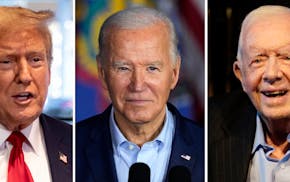Gov. Tim Walz proposed a bonding bill of $982 million on Tuesday, with nearly half going toward shoring up existing state infrastructure.
The governor's proposal is an early step in the process, setting a framework and tone for the Legislature which goes into session Feb. 12. The DFL-controlled Legislature will weigh Walz's proposal and likely negotiate with him and Republicans over what to include.
"I'm excited about what we're able to do," the DFL governor said in releasing his proposal that he said will create good-paying labor jobs throughout the state as the projects are built. "We're finally seeing the golden age of construction and infrastructure in Minnesota."
The governor released his proposal at the Capitol with labor union members standing behind him. His plan includes $830 million in general obligation bonds.
Both Walz and Minnesota Management and Budget Commissioner Erin Campbell said the chosen projects address deferred maintenance on state buildings. Upkeep on those buildings is critical to maintaining the state's fiscal health and its Triple A bond rating, they said.
Unlike other spending proposals, bills that borrow money require a supermajority of more than three-fifths in both chambers of the Legislature, meaning the DFL needs Republican votes for passage. Especially tricky is the Senate where the DFL has a mere 34-33 edge over the GOP.
In the governor's proposal, 45% goes to preserving infrastructure, 22% toward water and transportation, 14% to public safety, 10% to housing and 9% to other projects, according to Walz.
The lead Republican on the Senate Capital Investment Committee said her caucus is still deciding on bonding priorities.
"I am concerned there isn't more money in this proposal for local needs across the state," Sen. Karin Housley, R-Stillwater, said in a statement. "Wastewater treatment and crumbling roads might not be glamorous, but they are the basic necessities that every community needs to thrive."
Walz wants to spend $215 million on water and transportation projects, including $119 million for grants and low-interest loans for safe drinking water. He proposed $28 million for new grant programs to help remove water contaminants such as PFAS, which are human-made chemicals linked to some cancers.
Saying that "everyone in Minnesota deserves to be safe and protected," the governor proposed using $142 million on public safety projects, including $48 million to acquire land and design a new Bureau of Criminal Apprehension Southern Regional Office and Laboratory.
He would also dedicate $22 million to acquire land and design a Twin Cities headquarters for the State Patrol.
The patrol leases space in a downtown St. Paul office building and its operations hubs are spread throughout the Twin Cities, making them "about as fragmented and disjointed" as imaginable, State Patrol Chief Col. Matt Langer said.
The headquarters location has yet to be chosen.
Walz also wants to spend $47 million to expand educational and rehabilitative services for inmates at the state's prison in Rush City. Corrections Commissioner Paul Schnell said the facility has limited programming for inmates because of space constraints.
Walz's proposal includes more than $97 million for housing and environmental projects. Half that amount would go toward Housing Infrastructure Bonds to support construction of multifamily housing for those facing homelessness, seniors and families.
Some $16 million of the housing money would be used to update the Minneapolis Veterans Home.
Another $440 million of his proposal would "maintain and renew the buildings that taxpayers own and rely on every day," he said. Included in that number is nearly $206 million for Minnesota State and the University of Minnesota to repair and renovate buildings.
An additional $85 million will go toward other infrastructure across the state including $40 million for local government projects and $5 million in grants to construct and renovate early childhood facilities.
Walz didn't include money for U.S. Bank Stadium or Xcel Energy Center in his proposal. The Minneapolis stadium needs $62 million for the second phase of its secure perimeter. St. Paul is working on a pitch to the state for help renovating Xcel, a cost that could reach hundreds of millions of dollars.
The governor said he has yet to receive a formal request from St. Paul, but said discussions about Xcel and the stadium would occur during the upcoming session.
In even-numbered years, the Legislature typically focuses on passing a package of construction projects. But last session, Walz and legislative leaders struck a deal on a $2.6 billion infrastructure package — the largest in state history — after failing to come to an agreement on one in 2022.
That package was made up of $1.5 billion of borrowing and more than $1.1 billion in cash, and included funding for upgrades to college buildings, road and bridge improvements and water infrastructure projects. Democrats were able to get Republican support for the bill after agreeing to send $300 million to distressed nursing homes.
The state's latest economic forecast accounted for an $830 million general-obligation bonding bill this year, but lawmakers can use part of a projected $2.4 billion budget surplus to pay for some projects in cash.

'Running against a 6-year-old': Biden lets Trump jokes fly at annual roast

Fact-checking Trump's remarks in the hush money trial
Have you heard the one about Trump? Biden tries humor on the campaign trail
